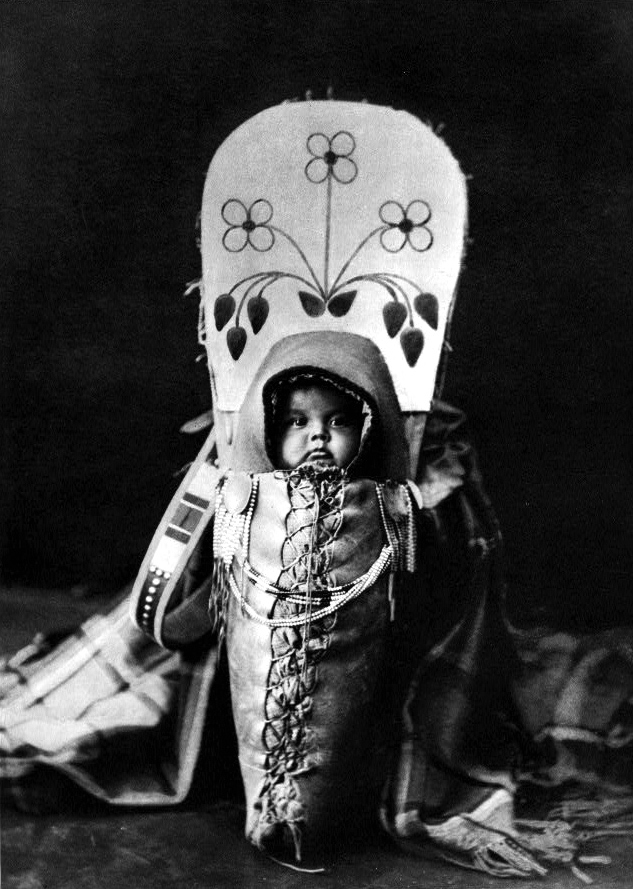Line 53: “My father’s cannery”- Crane’s father owned a maple syrup cannery in Warren, Ohio (Baker 53).
Line 54 and Line 56: “Rail-squatters” and “Hobo-trekkers”- Both homeless railway figures that Crane recalls seeing from his childhood home by a railroad in Warren, Ohio.
Line 66: “reprobates”- [those who are] “rejected by God” (OED). Crane is referring to old, lost hobos.
Line 70: “valley-sleepers”- This could be referring to sleeper trains that ran on the Ohio Valley Railroad Company.
Line 74: “Her”- Due to the nature of the section and the other references in the poem to Native Americans, “Her” is referencing Pocahontas, or “Powhatan’s Daughter.”

"A Photograph of the "Sedgeford Portrait" to Represent Pocahontas and Son." (1935). Courtesy of Wikimedia Commons.
Line 75: “Trains”-Reference to the Pullman train.
Line 77: “Papooses”- A Native American Indian Child (Wikipedia).
Line 78: “Redskin Dynasties”-A reference to the vast Indian presence that is in the Midwest, the topic of interest for Crane in this poem. See “The Dance” for further references to Indians (“the serpent and the eagle”).
Line 82: “Ozarks”-Of or relating to the Quapaw people or their language (Oxford English Dictionary).
Line 82: “Iron Mountain”-From context, “Iron Mountain” is a reference to the Ozark region of Quapaw people, located in Missouri.
Line 83-86: “Old gods of the rain…eatage”- These lines are most likely a reference to an ancient Indian myth. The lines are placed within the context of “Iron Mountain,” meaning the “old gods of the rain” are Indian gods buried deep in the mountain and are being fed kernels of corn from “eyeless fish” and “querulous crows” (Brunner 198).
Line 90: “Pullman breakfasters”- Passengers on the Pullman train dining.
Line 93: “Siskiyou”- A mountain range that exists in Northern California and Southern Oregon. This could also refer to the Siskiyou trail, an Indian trail that extended from Oregon to California (Wikipedia).
Line 95: “Cairo”- There are many locations named “Cairo” across the United States, but because of the later geographical reference of seeing the “Ohio merging,” this references Cairo, Illinois. Here, the Mississippi and the Ohio River converge (Wikipedia).
Line 96: “Ohio”- The Ohio River.
Line 96: “Tennessee”- The Ohio merges into the Tennessee River, the largest tributary of the Ohio River (Wikipedia).
Line 100: “Memphis Johnny”- This could either refer to a song or is a nickname for the various rivers referenced in the poems.
Line 100: “Steamboat Bill”- This could either refer to a song or is a nickname for the various rivers referenced in the poems. Here are the lyrics for the song that this line references.
[tubepress video=”P-RR6R609sE” fullscreen=”false” embeddedHeight=”28″ length=”false” views=”false”]
“Steamboat Bill.” (1919). Courtesy of Youtube.
Line 100: “Missouri Joe”–This could either refer to a song or is a nickname for the various rivers referenced in the poems.
[wpaudio url=”http://ia600305.us.archive.org/10/items/SophieTucker-31-40/SophieTucker-MissouriJoe1911.mp3″ text=”Sophie Tucker, ‘Missouri Joe’ (1911)” dl=”0″]
Courtesy of Internet Archive.
Line 104: “Deep River” Here are the lyrics for the song that this line references.
The Harmonaires, ‘Deep River’ (1947?)
Courtesy of Internet Archive.









